

Scanning and Your EHR Implementation. For small practices, moving from a paper medical record system to an electronic medical record system, scanning documents play an important role in a successful implementation.
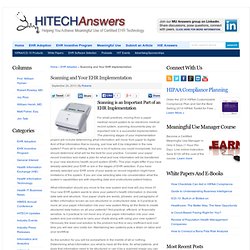
The planning stages of your implementation project will include determining what information will move from paper to digital. And of that information that is moving, just how will it be integrated in the new system? From all to nothing, there are a lot of options you could incorporate, but you should determine what will be the best for your practice. Consider your paper record inventory and make a plan for what and how information will be transferred to your new electronic health record system (EHR). This plan might differ if you have already selected your EHR or are in the stages of EHR selection.
What information should you move to the new system and how will you move it? So the solution for you will be somewhere in the middle of all or nothing. This post was sponsored by Canon U.S.A. EHR Adoption - Planning - Chart Migration. Chart Migration is the process of moving information from the paper record to the EHR – also known as chart abstraction, or chart conversion.
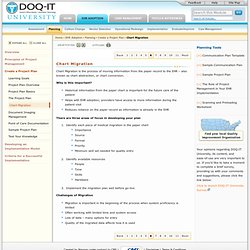
Why is this important? Historical information from the paper chart is important for the future care of the patient Helps with EHR adoption; providers have access to more information during the patient visit Reduces reliance on the paper record as information is already in the EHR There are three areas of focus in developing your plan Identify each piece of medical migration in the paper chart Importance Source Format Priority Minimum skill set needed for quality entry Identify available resources People Time Skills Hardware Implement the migration plan well before go-live Challenges of Migration. Cshca.wpengine.netdna-cdn.com/wp-content/uploads/2011/06/4-Medical-Records-Conversion-Tips-for-Success.pdf. EMR-Bear. This is a description of a proven method to migrate paper charts to your new EMR-Bear.

It might as well be a useful reference for any other EMR migration. Many implementations are known for having a huge impact on productivity. This is mostly true due to the lack of organization. Some other times the problems are due to over-thinking, over-meeting, and resource over-spending to discuss and engineer a process that is rather simple and straight forward. Pre-requisites, Processes and Storage will be discussed and guidelines provided to help you implement you own policy and methodology in an effective way and short time. The pre-requisites for starting the paper migration to EMR are the following. Scanner Have a good quality scanner that supports document feeding, automatic conversion to PDF (Adobe Acrobat’s portable document format), and double side scanning. Scanner methodology Decide whether your will partition the chart in sections or if you’ll input the scanned charts as a single entity.
Physician-resources/PhysRes-EMR-Planning.pdf. How to Implement Your EHR System. Implement System The process of implementing an EHR can be made more systematic, efficient, and less prone to problems by following these nine steps: Create an EHR Implementation Plan Building on the initial project planning, it will be necessary to work with the vendor to create a brief road map for the implementation tasks.
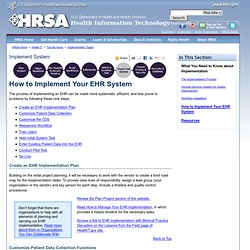
To provide clear lines of responsibility, assign a lead group (your organization or the vendor) and key person for each step. Include a timeline and quality control procedures. Review the Plan Project section of this website. EHR Adoption - Planning - Chart Migration. Cshca.wpengine.netdna-cdn.com/wp-content/uploads/2011/06/4-Medical-Records-Conversion-Tips-for-Success.pdf. EMR-Bear. How to Integrate EHR / EMR Systems. Installing or upgrading to a new EMR / EMR system requires careful planning to integrate your data and make sure your office workflow is either properly supported or that needed changes are identified.
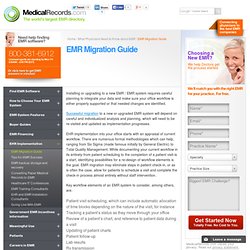
Successful migration to a new or upgraded EMR system will depend on careful and individualized analysis and planning, which will need to be re-visited and updated as implementation progresses. EHR implementation into your office starts with an appraisal of current workflow. There are numerous formal methodologies which can help, ranging from Six Sigma (made famous initially by General Electric) to Total Quality Management. While documenting your current workflow in its entirety-from patient scheduling to the completion of a patient visit-is a start, identifying possibilities for a re-design of workflow elements is the goal. Key workflow elements of an EMR system to consider, among others, are: EMR migration and integration is a recursive process that should involve all staff members. How to Implement Your EHR System. Physician-resources/PhysRes-EMR-Planning.pdf. EMRs: Your transition from paper. During the change to an electronic medical record system, the focus for many practices is on how data will be collected, stored and analyzed going forward.
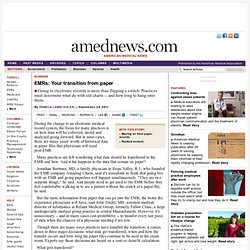
But in most cases, there are many years' worth of historical data in paper files that physicians will need post-EMR. Many practices are left wondering what data should be transferred to the EMR and how. And what happens to the data that remain on paper? Jonathan Bertman, MD, a family physician in Hope Valley, R.I., who founded the EMR company Amazing Charts, said it's unrealistic to think that going live with an EMR and going paperless will happen simultaneously. "They are two separate things," he said. But the more information from paper that can go into the EMR, the better the experience physicians will have, said John Trudel, MD, assistant medical director of informatics at Reliant Medical Group, formerly Fallon Clinic, a large multispecialty medical group practice in central Massachusetts. What gets transferred? Robert M.